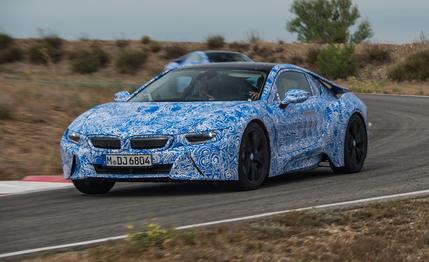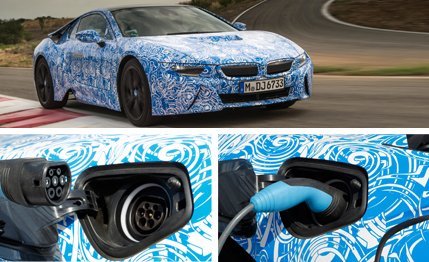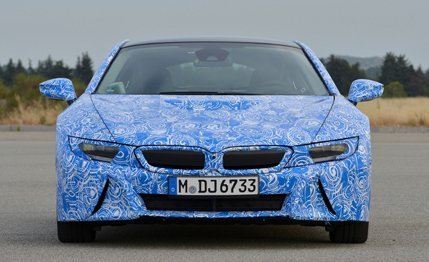 Prototype Drive
Prototype Drive
Some cars defy easy classification. BMW has referred to its i8 as “the most progressive sports car of our time,” extending “sustainability to a new vehicle segment.” BMW North America president and CEO Ludwig Willisch has said the i8 “will compete with supercars with its looks and driving performance.” At the same time, BMW claims this plug-in hybrid will be able to drive as far as 22 miles on electric power alone and achieve about 95 mpg—at least on the European test cycle, which provides an advantage to the electric side of the ledger (as does the EPA test). Our admittedly spitballed estimates—there really isn’t a commensurate plug-in for which we have data—for real-world combined-system driving are 40 mpg city and 45 mpg highway.
We had a chance to drive a preproduction i8, disguised with blue contact paper that made the car look as if it had been decorated by a white-crayon-wielding kindergarten class. Here’s what we learned: Even with the ridiculous disguise, the i8 is visually exotic. Two inches longer, 4.6 inches wider, and 3.3 inches lower than a 4-series coupe, the i8 has the proportions of a mid-engine car, which it is—at least when you’re referring to the gas-drinking portion of its powertrain. The body has scissor doors and sports several flamboyant aerodynamic flourishes, including flat tunnels formed by the vertically extended rear fenders and lateral extensions of the C-pillars, underbody air intakes at the rear end of the side sills, bladelike ends on the rear fenders, and a radiator exhaust in the middle of the hood. Finished in gleaming paint, most likely two-toned to highlight its layered design language, the i8 will be a stunner.

Pop open the portals, and you first notice a high sill that combines with the overhead door to make entry a bit tougher than in a conventional car. Once inside, the cockpit is roomy and extremely well finished, with a layered design theme that matches the exterior. There’s a rear seat, but it’s a very tight fit for adults—think Porsche 911.
When you press the start button, the car goes into its default Comfort mode. If the battery is charged, you will start running under electric power, which is provided by a 129-hp motor powering the front wheels. It siphons power from a 6.0-kWh lithium-ion battery that’s located in the central tunnel within an aluminum structure. In this mode, the car is smooth, and it’s quiet and sprightly enough to keep up with normal traffic—subjectively, it feels about as quick as a Chevy Volt.
Step into the accelerator a little farther, and the transverse, mid-mounted turbo three-cylinder bursts to life with a growl. With its 228 ponies added to the mix, the 3300-pound i8 moves out smartly. BMW claims a 0-to-60 time of fewer than 4.5 seconds; with the gas engine making satisfyingly guttural sounds, the i8 feels every bit as quick as that, and we’re predicting a time of 4.3.

You don’t have to do any shifting, as the i8 is equipped with two automatic transmissions. There’s a two-speed gearbox for the electric motor to provide plenty of thrust in electric-only mode, which tops out at 75 mph. At higher speeds, the gas engine engages and the electric motor shifts into high gear to help it contribute to performance up to the 155-mph top speed. The 1.5-liter three-cylinder is coupled to an Aisin six-speed automatic borrowed from the Mini line. It’s beefed up to cope with the more powerful engine and gets a wider spread of ratios to better match the i8’s need for efficiency and performance.
All of this sounds like a lot of mechanical monkey motion, but it is essentially seamless in practice. The operation of the electric motor’s transmission is completely unnoticeable, and the six-speed coupled to the gas engine shifts as smoothly as any other automatic. The latter’s programming can be overridden by using the paddles on the steering column and engaging the gearbox’s Sport mode.